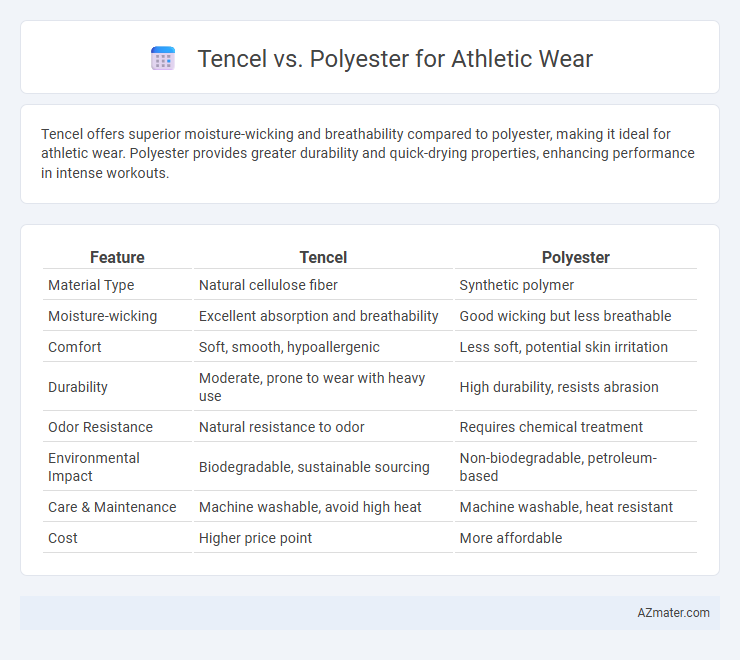Tencel offers superior moisture-wicking and breathability compared to polyester, making it ideal for athletic wear. Polyester provides greater durability and quick-drying properties, enhancing performance in intense workouts.
Table of Comparison
| Feature | Tencel | Polyester |
|---|---|---|
| Material Type | Natural cellulose fiber | Synthetic polymer |
| Moisture-wicking | Excellent absorption and breathability | Good wicking but less breathable |
| Comfort | Soft, smooth, hypoallergenic | Less soft, potential skin irritation |
| Durability | Moderate, prone to wear with heavy use | High durability, resists abrasion |
| Odor Resistance | Natural resistance to odor | Requires chemical treatment |
| Environmental Impact | Biodegradable, sustainable sourcing | Non-biodegradable, petroleum-based |
| Care & Maintenance | Machine washable, avoid high heat | Machine washable, heat resistant |
| Cost | Higher price point | More affordable |
Introduction: Tencel vs Polyester in Athletic Wear
Tencel and polyester differ significantly in athletic wear performance, with Tencel offering superior moisture-wicking and breathability due to its natural cellulose fibers. Polyester, a synthetic fabric, excels in durability and quick-drying properties but can retain odor and reduce comfort over extended use. Choosing between Tencel and polyester hinges on prioritizing natural comfort and environmental sustainability versus enhanced resilience and maintenance.
Material Origins: How Tencel and Polyester Are Made
Tencel is produced from sustainably sourced wood pulp, primarily eucalyptus, processed through a closed-loop system that recycles water and solvents, making it an eco-friendly choice. Polyester, derived from petrochemicals through a synthetic polymerization process, relies heavily on non-renewable fossil fuels, contributing to environmental pollution. The contrasting origins of Tencel's natural, biodegradable fibers versus Polyester's synthetic, petroleum-based composition significantly impact their sustainability and performance in athletic wear.
Moisture Wicking and Breathability Comparison
Tencel outperforms polyester in moisture wicking due to its natural cellulose fibers that absorb and release moisture efficiently, keeping athletes dry during intense workouts. Polyester excels in durability but tends to trap sweat and heat, reducing breathability and causing discomfort. The breathable structure of Tencel promotes air circulation and temperature regulation, making it a preferred choice for high-performance athletic wear focused on comfort and moisture management.
Comfort and Softness: Wearer Experience
Tencel fibers provide superior moisture-wicking and breathability, ensuring a cool, dry feel against the skin during intense workouts, while polyester tends to trap heat and moisture, which can cause discomfort. The natural softness of Tencel enhances overall wearer comfort, reducing irritation and chafing often encountered with synthetic polyester fabrics. Athletes seeking lightweight, breathable, and skin-friendly materials frequently prefer Tencel for its exceptional comfort and softness compared to conventional polyester.
Durability and Longevity in Sports Apparel
Tencel offers excellent breathability and moisture-wicking properties but generally lacks the abrasion resistance and tensile strength compared to polyester, making it less durable for high-impact sports activities. Polyester withstands repeated washing, stretching, and intense physical activity due to its strong synthetic fibers, contributing to superior longevity in athletic wear. Choosing polyester-based fabrics often ensures longer-lasting performance gear that resists wear and tear during rigorous training sessions.
Environmental Impact: Sustainability of Tencel vs Polyester
Tencel, derived from sustainably sourced wood pulp, offers significant environmental benefits such as biodegradability and lower water consumption during production compared to polyester, which is a synthetic fiber made from non-renewable petroleum resources. Polyester's production contributes to high carbon emissions and microplastic pollution, posing long-term ecological risks. Choosing Tencel for athletic wear supports reduced environmental impact through renewable sourcing and enhanced biodegradability, promoting sustainability in activewear.
Odor Control and Bacterial Resistance
Tencel fibers naturally inhibit bacterial growth and offer superior odor control by wicking moisture away from the skin, making them ideal for athletic wear. Polyester, while durable and moisture-wicking, tends to retain odors as bacteria can thrive on synthetic fibers. Choosing Tencel enhances comfort and hygiene during intense workouts due to its antimicrobial properties.
Care, Maintenance, and Washing Requirements
Tencel athletic wear requires gentle washing with cold water and mild detergents to maintain its moisture-wicking properties and softness, avoiding bleach and fabric softeners to prevent fiber damage. Polyester garments are more durable in high temperatures, allowing machine washing with warm water and regular detergents but can retain odors if not properly dried. Both fabrics benefit from air drying over high-heat drying to preserve elasticity and prolong garment lifespan.
Cost Analysis: Affordability and Value
Tencel offers a higher initial cost compared to polyester, but its durability and moisture-wicking properties provide better long-term value for athletic wear. Polyester is more affordable upfront, making it a popular choice for budget-conscious consumers seeking lightweight and quick-drying fabric. Evaluating cost-effectiveness involves balancing the premium price of Tencel with its sustainable advantages and enhanced comfort during intense physical activity.
Conclusion: Best Choice for Athletic Wear
Tencel outperforms polyester in athletic wear due to its superior moisture-wicking, breathability, and eco-friendly properties, making it ideal for high-performance workouts and sensitive skin. Polyester offers durability and quick-drying benefits but often lacks the comfort and sustainability of Tencel. For athletes prioritizing comfort, environmental impact, and natural fiber benefits, Tencel represents the best choice for athletic apparel.

Infographic: Tencel vs Polyester for Athletic Wear
 azmater.com
azmater.com